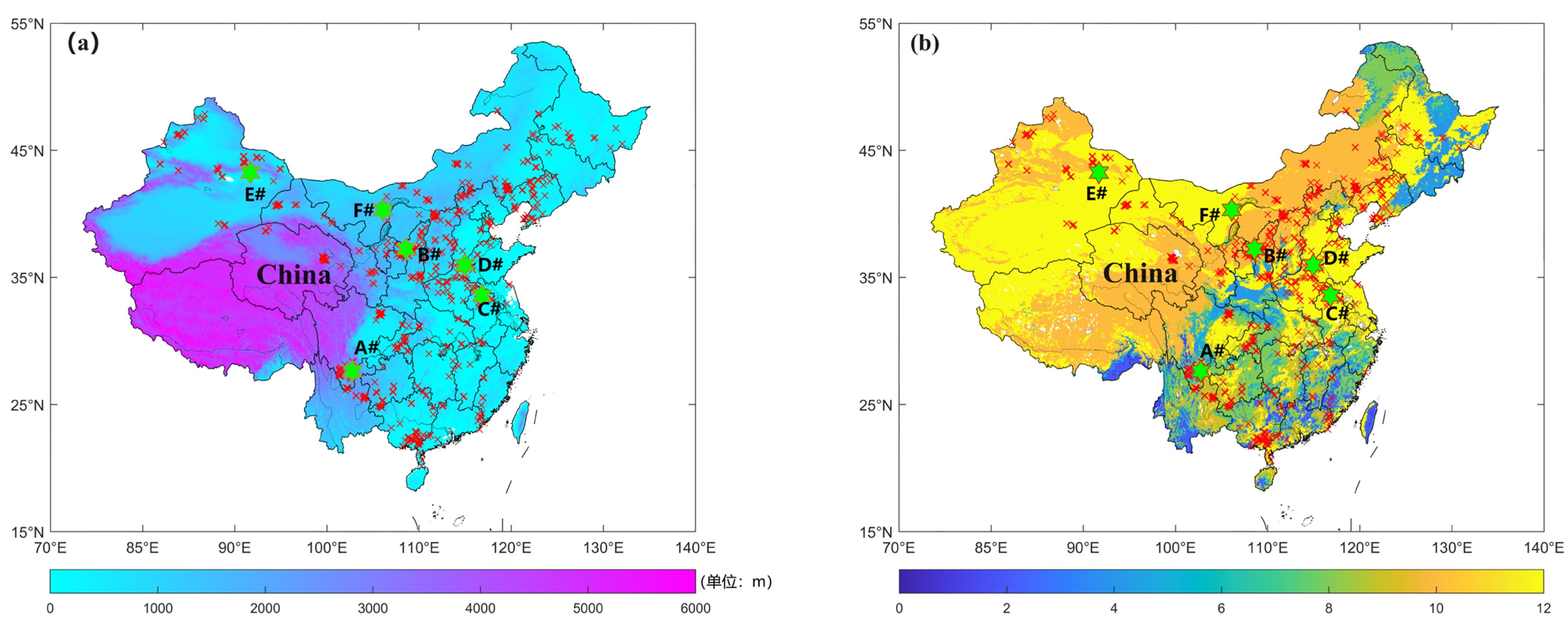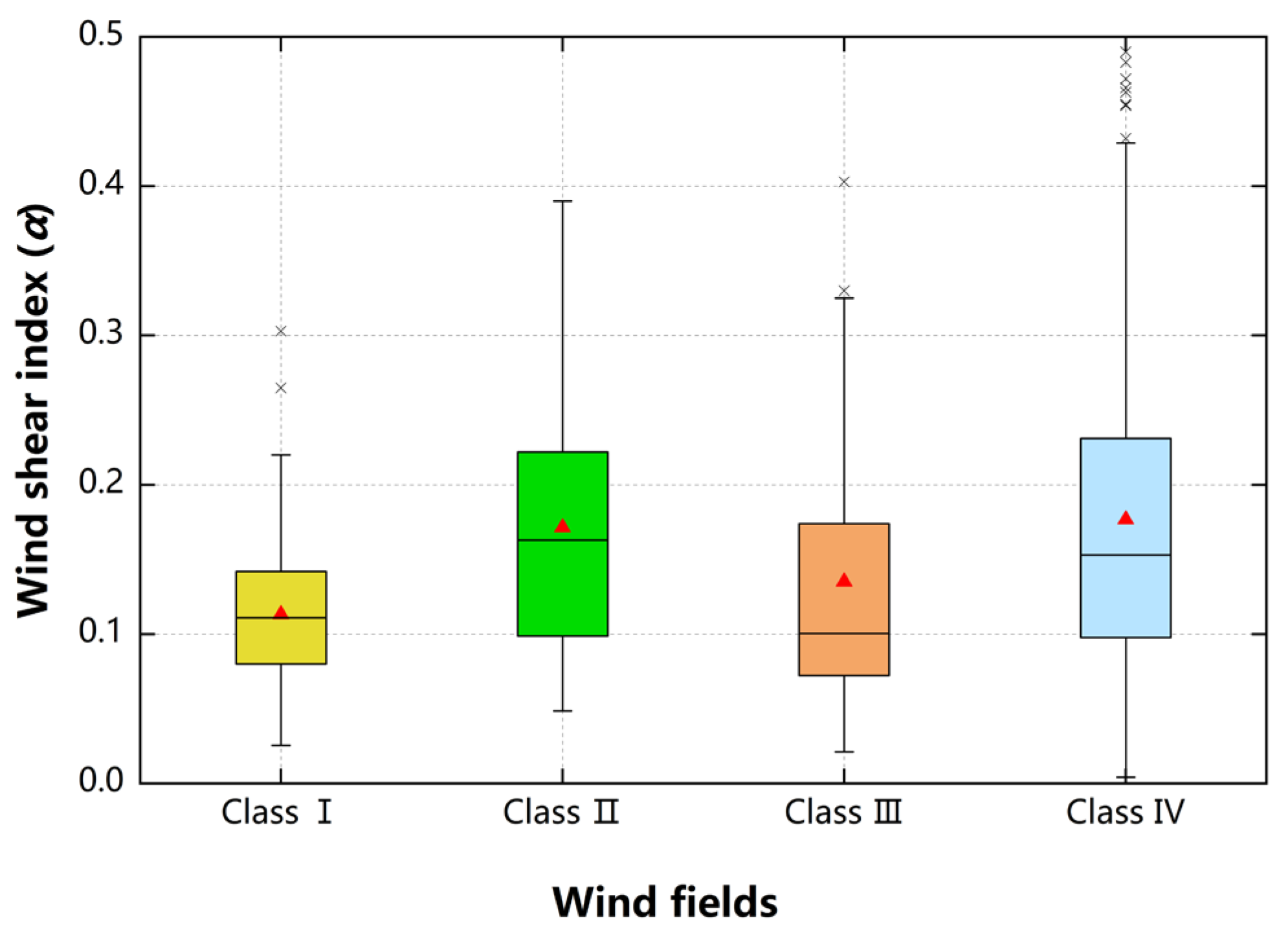Analysis of Near-Surface Wind Shear Characteristics over Land in China
Abstract
:1. Introduction
2. Materials and Methods
2.1. Observations of Wind Measurement Tower
2.2. Data Processing
- (1)
- Eliminate the data that do not conform to physical principles or typical climate statistical characteristics, such as horizontal wind speed ±20 m s−1, vertical wind speed ±10 m s−1, and temperature ±50 °C.
- (2)
- Eliminate data that are greater than five times the variance.
- (3)
- Eliminate static wind data with less than 0.1 m s−1. According to the 10 min wind speed and direction data, the hourly, daily, and monthly average wind speed and direction data are obtained through summation and averaging when the completeness of hourly, daily, and monthly data is greater than 90%.
- (4)
- When analyzing the monthly variation distribution characteristics, the selected wind tower site data must have completeness of wind data within a day higher than 95%, and the completeness of daily-scale valid data for each month must also exceed 95%. Then, arithmetic averages are computed for the valid data for each month from the complete annual wind data. For analyzing the diurnal variation distribution characteristics, the completeness of wind data at each hour on a daily and monthly scale from complete annual wind data must be at least 95%. Subsequently, arithmetic averages are calculated for the corresponding wind data at each hour.
2.3. Wind Shear Fitting Method
2.4. Distribution of Wind Resources Nationwide
- (1)
- Class I: Areas excluding Chifeng City, Tongliao City, Xing’an League, and Hulunbuir City in Inner Mongolia Autonomous Region; Urumqi City, Ili Kazakh Autonomous Prefecture, Changji Hui Autonomous Prefecture, Karamay City, and Shihezi City in Xinjiang Uygur Autonomous Region.
- (2)
- Class II: Zhangjiakou City and Chengde City in Hebei Province; Chifeng City, Tongliao City, Xing’an League, and Hulunbuir City in Inner Mongolia Autonomous Region; Zhangye City, Jiayuguan City, and Jiuquan City in Gansu Province.
- (3)
- Class III: Baicheng City and Songyuan City in Jilin Province; Jixi City, Shuangyashan City, Qitaihe City, Suihua City, Yichun City, and Daxing’anling Area in Heilongjiang Province; Areas excluding Zhangye City, Jiayuguan City, and Jiuquan City in Gansu Province; Areas excluding Urumqi City, Ili Kazakh Autonomous Prefecture, Changji Hui Autonomous Prefecture, Karamay City, and Shihezi City in Xinjiang Uygur Autonomous Region; Ningxia Hui Autonomous Region.
- (4)
- Class IV: Areas excluding the first three classes of resource areas.
2.5. Other Datasets
- (1)
- The topographic data in Figure 1 are derived from the Shuttle Radar Topography Mission (SRTM) Digital Elevation Model (DEM) (https://www.earthdata.nasa.gov/sensors/srtm, accessed on 6 May 2024).
- (2)
- The land cover classification data are sourced from the University of Maryland (UMD) Land Cover Classification Scheme based on MODIS data and other auxiliary data (https://glad.umd.edu/, accessed on 6 May 2024). This classification defines fourteen land cover types: ten natural vegetation types, two anthropogenic, and two non-vegetation types.
3. Results
3.1. Wind Shear Analysis over the Typical Underlying Surfaces
3.1.1. Wind Shear Fitting
3.1.2. Analysis of Diurnal Distribution Characteristics of Wind Shear
3.1.3. Analysis of Monthly Variations in Wind Shear Characteristics
3.2. Overall Wind Shear Characteristics
3.2.1. Overall Wind Shear Index Characteristics of Land Surface Regions in China
3.2.2. Wind Shear Characteristics in Different Wind Fields
3.2.3. Wind Shear Characteristics in Different Terrains
4. Conclusions
- (1)
- Wind shear index α, obtained from multi-year average wind data at different heights of wind towers, accurately characterizes the stratification of the atmospheric boundary layer near the surface.
- (2)
- The typical region’s wind shear index α exhibits larger and more stable values at night, significant variations during the morning and evening, and smaller yet stable values at midday. This pattern arises from the balance of surface temperatures due to solar solid radiation or its absence, resulting in uniform atmosphere mixing between upper and lower layers.
- (3)
- Wind shear monthly variations differ across sites with different underlying surface conditions. In mountainous and desert areas, they generally align with the typical pattern of being more prominent in autumn and winter and smaller in spring and summer. However, in plain areas, monthly fluctuations in wind shear are relatively minor.
- (4)
- The overall wind shear index for China’s land surface regions is 0.135. The α values for Class I, II, III, and IV wind zones are 0.111, 0.163, 0.1, and 0.153, respectively. The wind shear index α values for mountainous, plains, grassland, and desert areas are 0.12, 0.273, 0.123, and 0.104, respectively.
Author Contributions
Funding
Institutional Review Board Statement
Informed Consent Statement
Data Availability Statement
Acknowledgments
Conflicts of Interest
References
- Mahoney, W.P.; Parks, K.; Wiener, G.; Liu, Y.; Myers, W.L.; Sun, J.; Delle Monache, L.; Hopson, T.; Johnson, D.; Haupt, S.E. A wind power forecasting system to optimize grid integration. IEEE Trans. Sustain. Energy 2012, 3, 670–682. [Google Scholar] [CrossRef]
- de Jong, P.; Dargaville, R.; Silver, J.; Utembe, S.; Kiperstok, A.; Torres, E.A. Forecasting high proportions of wind energy supplying the Brazilian Northeast electricity grid. Appl. Energy 2017, 195, 538–555. [Google Scholar] [CrossRef]
- Liao, M.F.; Xu, K.; Wu, B.; Yuan, K.F. Effect of wind shear on wind turbine power. J. Shenyang Univ. Technol. 2008, 30, 163–167. [Google Scholar] [CrossRef]
- Wang, Y.; Cui, Y.F.; Yuan, H.L.; Song, J.B. Study on Calculation Method of Wind Shear Index in Plain Area. Northwest Hydropower 2019, 5, 95–99. [Google Scholar] [CrossRef]
- Optis, M.; Monahan, A.; Bosveld, F.C. Moving Beyond Monin–Obukhov Similarity Theory in Modelling Wind-Speed Profiles in the Lower Atmospheric Boundary Layer under Stable Stratification. Bound.-Lay. Meteorol. 2014, 153, 497–514. [Google Scholar] [CrossRef]
- Optis, M.; Bodini, N.; Debnath, M.; Doubrawa, P. New methods to improve the vertical extrapolation of near-surface offshore wind speeds. Wind Energy Sci. 2021, 6, 935–948. [Google Scholar] [CrossRef]
- Gong, X.; Zhu, R.; Li, Z.C. Study of Near-Surface Wind Shear Exponents of Different Regions in China. Meteorol. Mon. 2018, 44, 1160–1168. [Google Scholar] [CrossRef]
- Li, Y.; Liang, H.H.; Wang, S.D.; Zhou, Q.; Guo, X.X.; Qiao, H. Study of the Near Surface Wind Shear Daily Variation Characteristics Based on China’s Wind Power Resources Professional Observation Network. J. Nat. Resour. 2012, 27, 1362–1372. [Google Scholar] [CrossRef]
- Yuan, H.L.; Liu, J.T.; Chen, B.; Wang, Y. Analysis of Monthly Variation Characteristics of Surface Layer Wind Shear over Different Land Surfaces. Northwest Hydropower 2023, 4, 80–83. [Google Scholar] [CrossRef]
- Zhang, S.Y.; Hu, F. A study on effects of boundary layer meteorology to wind turbines’ power performance. Renew. Energy Resour. 2017, 35, 427–436. [Google Scholar] [CrossRef]
- Ryu, G.H.; Kim, Y.G.; Kwak, S.J.; Choi, M.S.; Jeong, M.S.; Moon, C.J. Atmospheric Stability Effects on Offshore and Coastal Wind Resource Characteristics in South Korea for Developing Offshore Wind Farms. Energies 2022, 15, 1305. [Google Scholar] [CrossRef]
- Touma, J.S. Dependence of the wind profile power law on stability for various locations. J. Air Pollut. Control Assoc. 1977, 27, 863–866. [Google Scholar] [CrossRef]
- Zhu, R.Z.; Xue, H. Calculation of Wind Energy and Distribution of Wind Energy Resources in China. Meteorol. Mon. 1981, 7, 26–28. [Google Scholar] [CrossRef]
- Hsu, S.A.; Meindl, E.A.; Gilhousen, D.B. Determining the power-law wind-profile exponent under near-neutral stability conditions at sea. J. Appl. Meteorol. 1994, 33, 757–765. [Google Scholar]
- Ramon, J.; Lledó, L.; Torralba, V.; Soret, A.; Doblas-Reyes, F.J. What global reanalysis best represents near-surface winds? Q. J. R. Meteorol. Soc. 2019, 145, 3236–3251. [Google Scholar] [CrossRef]







| Category | Number of Stations | Rate |
|---|---|---|
| Total | 754 | 100% |
| Land cover types | ||
| Mountains | 141 | 18.70% |
| Plains | 192 | 25.46% |
| Desert, gobi, and barren lands | 421 | 55.83% |
| Measurement duration | ||
| 1–2 years | 587 | 77.98% |
| 2–3 years | 110 | 14.72% |
| Above 3 years | 57 | 7.29% |
| Land Cover Types | No. | Measurement Period | Completeness Rate |
|---|---|---|---|
| Mountains | A# | 2013.11.13–2018.12.17 | 96.92% |
| B# | 2013.01.01–2021.12.31 | 99.58% | |
| Plains | C# | 2015.06.17–2020.07.13 | 98.91% |
| D# | 2017.05.14–2021.06.02 | 97.87% | |
| Desert, Gobi, and barren lands | E# | 2017.01.17–2018.07.18 | 100% |
| F# | 2013.07.01–2016.05.23 | 95.99% |
Disclaimer/Publisher’s Note: The statements, opinions and data contained in all publications are solely those of the individual author(s) and contributor(s) and not of MDPI and/or the editor(s). MDPI and/or the editor(s) disclaim responsibility for any injury to people or property resulting from any ideas, methods, instructions or products referred to in the content. |
© 2024 by the authors. Licensee MDPI, Basel, Switzerland. This article is an open access article distributed under the terms and conditions of the Creative Commons Attribution (CC BY) license (https://creativecommons.org/licenses/by/4.0/).
Share and Cite
Yuan, L.; Yang, F.; Ruan, X.; Zou, F.; Luo, Q. Analysis of Near-Surface Wind Shear Characteristics over Land in China. Atmosphere 2024, 15, 582. https://doi.org/10.3390/atmos15050582
Yuan L, Yang F, Ruan X, Zou F, Luo Q. Analysis of Near-Surface Wind Shear Characteristics over Land in China. Atmosphere. 2024; 15(5):582. https://doi.org/10.3390/atmos15050582
Chicago/Turabian StyleYuan, Ling, Fengzhi Yang, Xia Ruan, Feng Zou, and Qi Luo. 2024. "Analysis of Near-Surface Wind Shear Characteristics over Land in China" Atmosphere 15, no. 5: 582. https://doi.org/10.3390/atmos15050582





